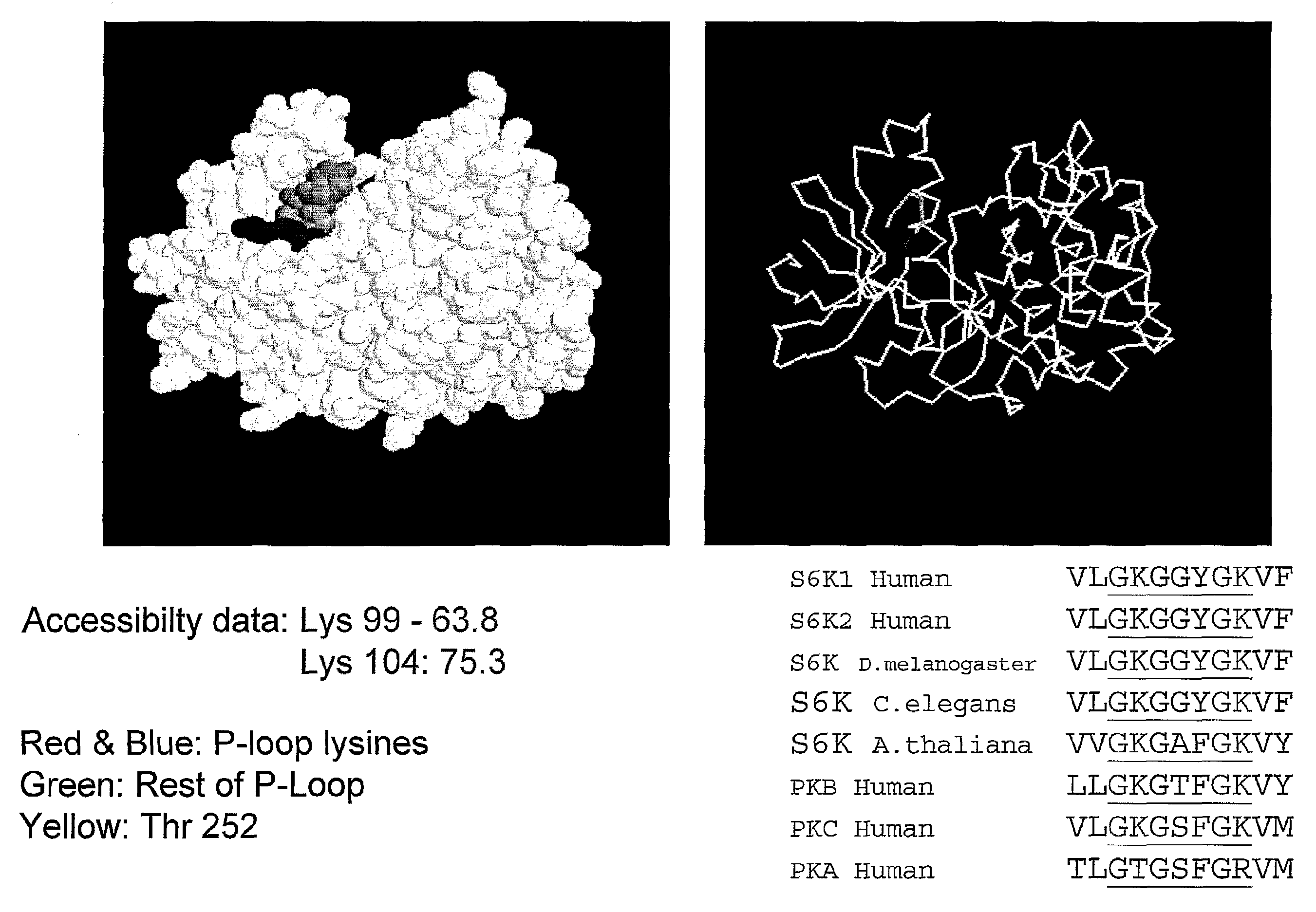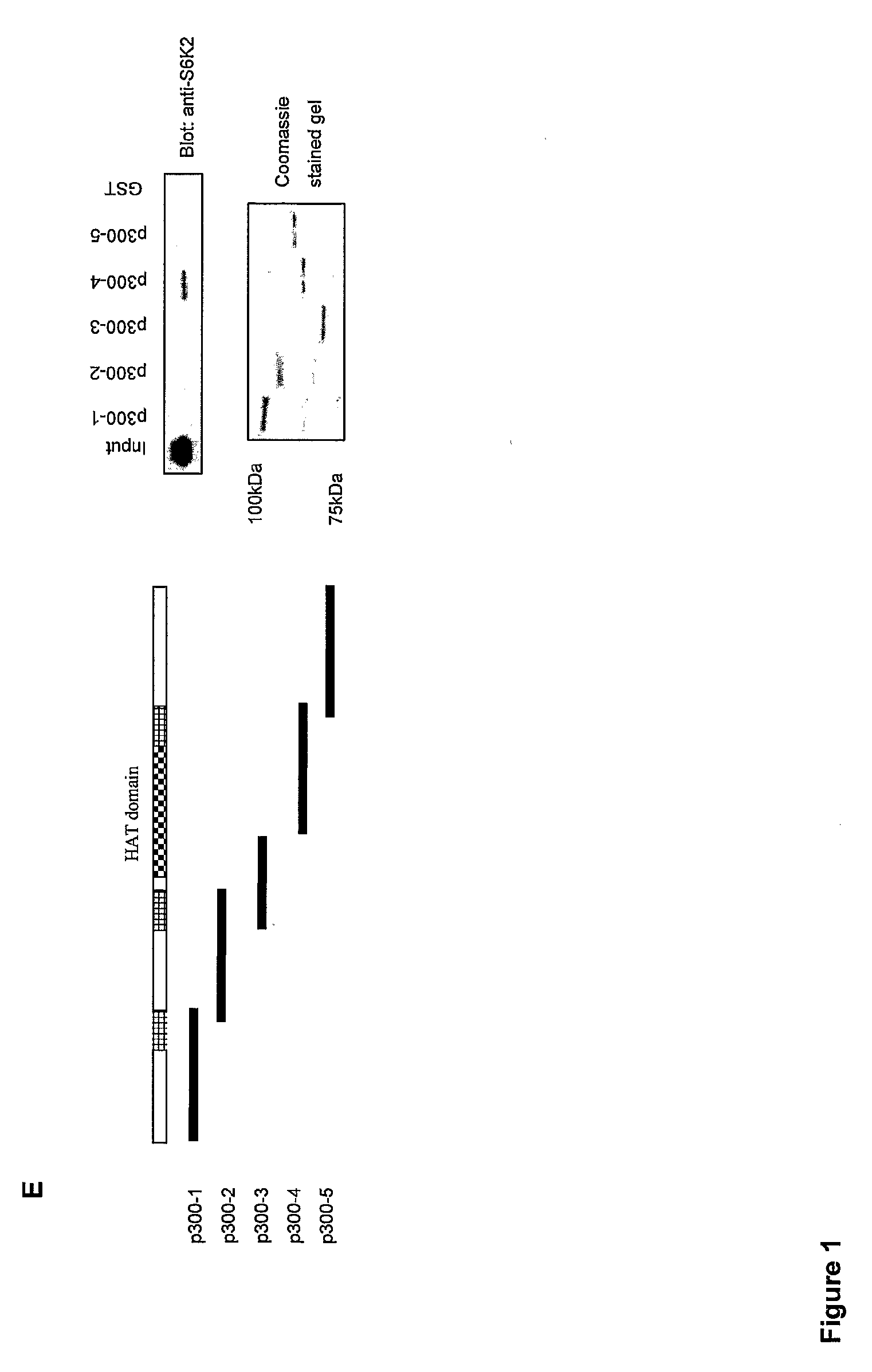Regulation of S6 Kinsase Protein Activity and Related Methods
- Summary
- Abstract
- Description
- Claims
- Application Information
AI Technical Summary
Benefits of technology
Problems solved by technology
Method used
Image
Examples
example 1
[0215]This example demonstrates that serum stimulation induces complex formation between p300 acetyltransferase and S6K1. Since S6 kinases appear to play a role in the regulation of transcription, it would be of interest to identify components of the transcriptional machinery with which they may interact. To this end, S6K1 and 2 were immunoprecipitated from MCF-7 cells before and after serum stimulation and blotting was carried out with a panel of antibodies to search for binding partners (data not shown). Interestingly, both isoforms of S6K show serum-inducible binding to the acetyltransferases, p300 and P / CAF (FIGS. 1A and D). Importantly, no p300 was detected in control immunoprecipitations using pre-immune sera from the rabbits used to produce the S6 kinase polyclonal antibodies. This demonstrates that the p300 interacts with the S6 kinases themselves rather than the anti-S6 kinase antibodies or protein A sepharose. The specificity of these interactions was further confirmed by ...
example 2
[0217]Since S6Ks can interact with a region within, or adjacent to the acetyltransferase domain of p300 we hypothesized that they may in fact be targeted by its enzymatic activity. This is indeed the case for two other proteins which bind to the p300-domain 4: Flap endonuclease-1 and DNA polymerase-β (Hasan et al. 2001b; Hasan et al. 2002) and for a number of proteins that bind to the third zinc finger region within domain 4, such as E1A, E2F, MyoD, SV40 large T and GATA-1 (Vo and Goodman, 2001). In order to test this possibility, recombinant S6K1 or 2 (1 μg) were incubated with GST-p300 HAT domain 4 or GST-P / CAF in HAT buffer containing 14C labelled acetyl coenzyme A (AcCoA). FIG. 2A shows that when S6K1 and S6K2 were incubated in the presence of GST-p300 HAT domain 4 or GST-P / CAF, 14C labeled acetyl groups were indeed incorporated into the proteins as visualized by autoradiographic detection of specific S6K bands following SDS-PAGE. Note that no label was incorporated into S6K1 or...
example 3
[0219]Having established that S6 kinases can be acetylated by p300 in vitro and in cells, attempts were made to find specific sites of acetylation in order to investigate the function(s) of S6 kinase acetylation. Recombinant S6 kinases were acetylated in vitro using either full length p300 or the recombinant p300 HAT domain. Reactions were carried out as before except that unlabelled AcCoA was used and the amount of S6 kinase was increased to 2 μg. S6 kinases were also incubated in the absence of p300 (termed un-acetylated samples). Reaction products were separated by SDS-PAGE, gels were stained with Coomassie blue and S6 kinase bands from both acetylated and un-acetylated samples were excised and subjected to in-gel digestion with trypsin or Arg-C prior to analysis by MALDI TOF mass spectroscopy.
[0220]Initially, peptide mass fingerprints were acquired to check that the in-gel digestion was satisfactory, to establish the protein identification, and to look for putative acetylated pe...
PUM
| Property | Measurement | Unit |
|---|---|---|
| Protein activity | aaaaa | aaaaa |
Abstract
Description
Claims
Application Information
 Login to View More
Login to View More - R&D
- Intellectual Property
- Life Sciences
- Materials
- Tech Scout
- Unparalleled Data Quality
- Higher Quality Content
- 60% Fewer Hallucinations
Browse by: Latest US Patents, China's latest patents, Technical Efficacy Thesaurus, Application Domain, Technology Topic, Popular Technical Reports.
© 2025 PatSnap. All rights reserved.Legal|Privacy policy|Modern Slavery Act Transparency Statement|Sitemap|About US| Contact US: help@patsnap.com



